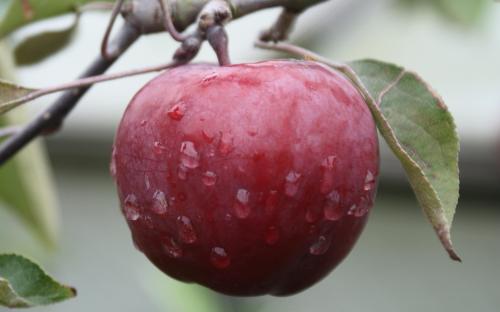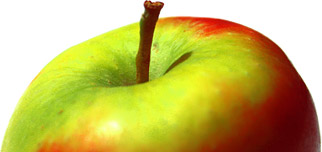
Most apples have white or nearly-white flesh, but a small number of varieties have pink or even deep red flesh. The gene for red-fleshed apples seems to have come from a crab apple, and many of these varieties have crab-apple characteristics, including relatively poor flavour. Almata is an exception, in that the flavour is reasonably good (although certainly not outstanding).
The apples are small, round-conical, about two inches in diameter. The stalk is of medium length, fairly thick, in a shallow cavity, projecting beyond the base. The skin is wholly red and smooth, with a greyish bloom. The flesh is deep pink, soft, and tender; the juice is sweet and tart. The eye is closed and there is little or no cavity. The appearance is very similar to Scarlet Surprise (also American) and Huonville Crab (Australian). There are apples in most years, though there is a slight tendency to be biennial.
This apple is more acidic than typical dessert varieties, having an intense sharp brisk flavour. It keeps in good condition for about a week. After this time it is sweeter and less acidic. The flesh texture is not as crisp as Scarlet Surprise. In sunny years when fully ripe it can be sweet on the day of picking.
The tree is slender and partial tip-bearing. The blossom is wholly red, new leaves are bronze-coloured, and the wood is pigmented red. The flowering period is early; about 14 days earlier than Bramley. It is an effective pollinator. The tree grows quite vigorously and there is no susceptibility to woolly aphis or mildew.
We are grateful to Nigel Deacon, an English apple enthusiast with a particular interest in red-fleshed apple varieties, for samples and background of this apple variety. There are details of many more red-fleshed apples on his website and he can supply / exchange seeds and scionwood - see Diversity website.
Almata apple identification images
All images copyright Orange Pippin unless otherwise stated.
USDA identification images for Almata
The identification paintings in the USDA Pomological Watercolor Collection span the years 1886 to 1942.
Citation: U.S. Department of Agriculture Pomological Watercolor Collection. Rare and Special Collections, National Agricultural Library, Beltsville, MD 20705.
See also
- Red Devil - red-fleshed apple varieties
- Rosette
- Scarlet Surprise
Visitor reviews
- 15 Aug 2015 UTAH, United StatesI have three apple trees. They only produce everyother year.they are a red apple when fully ripe with a yellowish white center.good for applesauce,jelly,juice,pie ect. All I have been told is that they are a winter apple. They kinda look like the Almata to me but not sure.these trees are over 100 years old.I put out a free apple sign and people come from all over to pick them.. It seems like they have a blast.and so do the deer.
- 03 Aug 2012 CO, United StatesI have two of these, they ripen in late July / early August. I find the taste rather remarkable, its tart, makes great pies, dried apples, etc. I get a decent crop every year, not something I can say for all the other varieties I gro.
- 09 Jan 2012 SOUTH DAKOTA, United Statesi have the same, issue as Helpplz form the united kingdom. the fruits on my tree are more of an oval shape. Also is this an apple tree, or a crabapple tree
- 13 Aug 2011 United Kingdomi have a small apple tree in my garden which resembles the almata apple but i,m not sure it is. i,ve searched the web and the almata resembles it 'most only difference is my apples are more oval, can you help
Tree register
United States
- Bart Popowski in Hermosa, SOUTH DAKOTA
- Dan Vorhis in FREELAND, WA
- Emma R. in Winchendon, MA
- Jeannie Berg in Scio, OR
- Jerry Hudgins in Point Reyes Station, CALIFORNIA
- Jessica Klein in Maple Valley, WASHINGTON
- Ricky Bruckner in Ravenna, OHIO (OH)
- Shirley Morelli in Northport, WA
- Thomas Griffith in Cottage Grove, WI
United Kingdom
- Carl Hart in NORTHAMPTONSHIRE
Canada
- Erik Nordenson in Cobourg, ONTARIO
- Roger Macpherson in Delta, B.C.
Russia
- Ann in Manturovo, KOSTROMA OBLAST
Harvest records for this variety
2011 season
- 1st week October 2011 - tree owned by Carl in , United Kingdom
Origins
- Species: Malus domestica - Apple
- Parentage: (Beautiful Arcade x Fluke 38) x Redflesh cross
- Originates from: South Dakota, United States
- Developed by: Niels Hansen
Identification
- Country of origin: United States
- Period of origin: 1900 - 1949
- Fruit colour: Red - dark
- Flower colour: Pink - dark
- Leaf colour: Bronze
- Annual cycle: Deciduous
- Flesh colour: Pink / Red
- Fruit size: Small
- Fruit shape: Round
Using
- Picking season: Early
- Keeping (of fruit): 1 week
- Flavour quality: Average
- Flavour style (apples): Sharper
- Juice style: Sharper
- Cropping: Light
- Fruit persistence: Normal ripening
- Food uses: Culinary
- Food uses: Juice
- Juice colour: Pale red
- Picking period: late August
- Wildlife: RHS Plants for Pollinators
Growing
- Gardening skill: Experienced
- Flowering group: 1
- Pollinating others: Poor
- Ploidy: Diploid
- Vigour: Slightly large
- Bearing regularity: Biennial tendency
- Fruit bearing: Partial tip-bearer
- Attractive features: Attractive flowers
- Self-fertility: Not self-fertile
- Attractive features: Attractive foliage
Climate
- Cold hardiness (USDA): Zone 3 (-40C)
- Summer average maximum temperatures: Cool ( 20-24C / 68-75F)
- Summer average maximum temperatures: Warm (25-30C / 76-85F)
Other qualities
- Disease resistance: Average
- Powdery mildew: Some resistance
- Scab (Apple and Pear): Some susceptibility
- Fire blight: Some susceptibility
Where to buy trees
The following tree nurseries offer Almata apple trees for sale:
- Orange Pippin Fruit Trees (USA) United States
Almata apple trees
Where to buy fresh fruit
The following orchards grow Almata:
United States
Idaho
- BYU-Idaho Apple Orchard Museum, Rexburg
Wisconsin
- Door Creek Orchard, Cottage Grove

